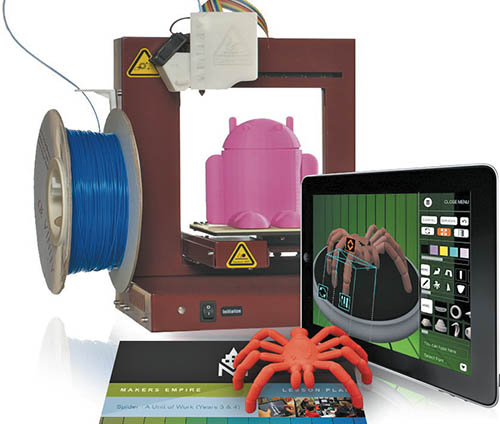
The beauty of being in IT, heading up The Garb Consulting IT Group, managing technology of many educational institutions, is we get to see what our children are learning today and what they will be learning in the future. As many have heard, someone on the internet downloaded a diagram of braces for $50 and installed them on his teeth. This person used a 3D printer.
Here’s a brief explanation of what 3D printing is. The 3D printer gives the user the ability to “make.” Meaning from an application, one can design, for example, a new pair of Nike sneakers. This is a real concept I have heard companies are playing with. The user adds touches like colors; maybe one shoe will be bigger than the other with your name on it, etc. Then the user will actually “print” the sneakers using the filament that they have also purchased. The filament is the printer’s “ink.”
Imagine a time when, instead of buying a pair of sneakers online, people buy the diagram, then download and print the sneakers in their homes. Or on Chanukah, a grandparent will purchase the designs for the toy and the grandchild prints the toy at home. Sounds Jetson-like, futuristic! But this is happening and it’s spreading like wildfire in every industry.
Many colleagues of mine have purchased a 3D printer and are creating hard-to-come-by parts for machinery. The process and output time of the printings decreases depending on the amount of money you spend on the 3D printer. Basically, the more expensive the machine, the faster the processing. Be wary of deals or DIY kits. I tried several and they were very difficult to use.
The market is about to explode as you will all see, but I believe that someday having a 3D printer in one’s home will be as common as having a microwave.
The Garb Consulting IT Group manages the technology at Yeshivat He’Atid in Bergenfield. Of course, there are so many great schools here in Bergen County, though I have the privilege of seeing the amazing staff at Yeshivat He’Atid teach the students subjects that are in the now and in the future.
Last week Mr. Lap Leung from Makers Empire (www.makersempire.com, email: lap@makersempire.com) gave a presentation to the students. The software alone allows the students to “make” diagrams, toys, doodles, even something as simple as a cup. This isn’t just picking templates and printing. The students are able to flip the diagram and edit the template from all angles. Then the students make that design theirs. I never thought just making a cup would be a challenge. Of course one has to first remove the area where liquids will go. Seems simple, but there’s a learning curve. There is a diagram where the student can create a figure of a boy, a girl or a troll. The student can change every aspect of the body and this is 3D. The student can move and view the 3D person from every angle. Once complete, the boy/girl/troll can wave, flip, run and do other actions. Imagine what a biology teacher could do with a tool this lifelike.
I had time to sit with Mr. Leung. He gave me one-on-one training as if I were one of the students. He is extremely passionate and excited by the 3D-printer industry. (His Australian accent made the class all the more exciting.) Leung mentioned that the 3D printer at first was viewed as just another piece of technology that goes in the computer lab. However, Lap explained, the 3D printer can be used to teach math, science and even biology. The intent of Makers Empire is to educate teachers and students alike on the possibilities of 3D printing. A lot of thought and time went into the software. There are lesson plans, curriculum standards for New York, New Jersey and other states and countries throughout the world. The teachers’ experiences are easily integrated in the portal to make assisting the students easy and quick.
Leung said, “Through participating in 3D printing, students develop important skills in design thinking, critical analysis and problem solving. Importantly, helping them nurture their innovation and creative talents, [we] allow students to come up with new ideas, new solutions and new knowledge to take on future challenges in the 21st century.”
There are many brands and types of 3D printers to choose from. The prices of these printers are quite high for now, but as the supply and demand rise, the cost will drop. The filament (ink) looks like a spool of lanyard, which is a Lego-type plastic when printed. If the printing output is going to be used for food vessels, food-grade filament should be purchased.
A 3D printer site and brand I would recommend is Afinia, http://afinia.com/. One can purchase the filaments, 3D scanners and printers all on the site. There are great how-to videos and tutorials as well. Alternatively, XYZ on Amazon is something people can look into. The prices range from $400 to $1200 a printer.
A key idea that Leung shared resonated with me: “Student and standard users are moving from mass production to mass customization, mass personalization.” That line hit me like a rocket.
It is an incredible time to get students and our children out of playing games and texting when they can become users of this technology. Let’s get our children making, weather it’s 3D printing or writing code. We need to tap back into using technology to create, as with the 3D-printing industry. Educate, make and create.
Printing shoes? Dinnerware? Hard-to-find parts? Smartphones? Who knows what’s next? 3D printing is just the tip of the iceberg. I can’t wait to see what’s next.
By Shneur Garb
Shneur Garb is the founder and Senior Engineer at the Garb I.T. Consulting Group in Teaneck, NJ. Shneur leads technology seminars and training for various businesses and educational institutions in the US and Canada. For questions, email shneur@garbcg.com.









